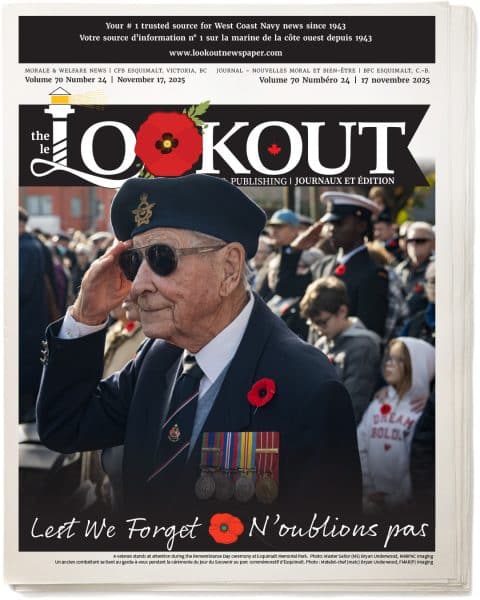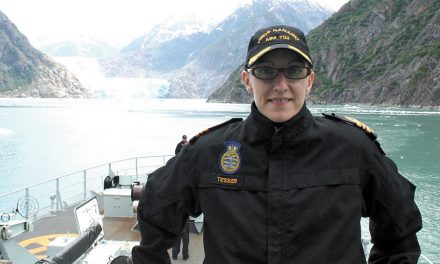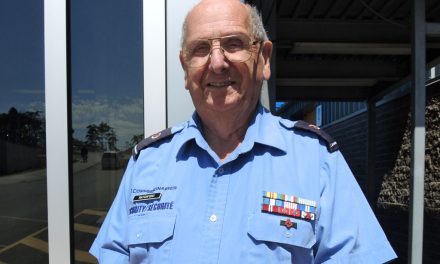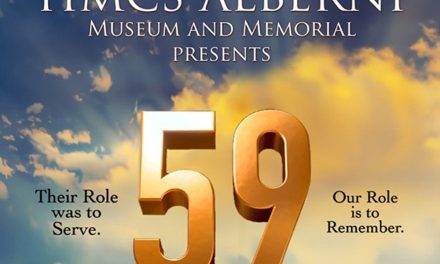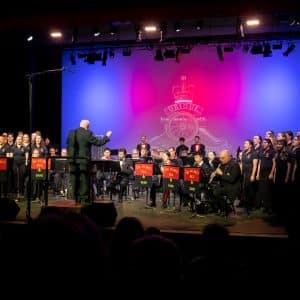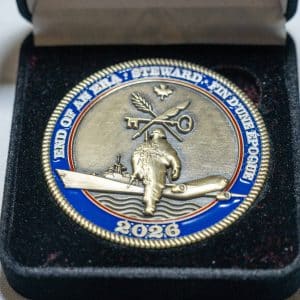
Top right: Corrections Canada employee Marcia Koenders displays an image of her friend Vicki Black. Black was murdered in Vancouver in 1993 and it took decades to find her killer. Bottom: Military members and public service employees gather for a group shot during a Movement is Medicine event, May 3 at Clover Point. Photos: Peter Mallett/Lookout Newspaper.
Peter Mallett,
Staff Writer
—
With every forward step, Marcia Koenders hopes to shine a bright red light on the plight of missing and murdered Indigenous girls and women.
“I walk for these women to honour their lives cut short and also for me, because if it wasn’t for the kindness of strangers then maybe I could have been on that list too,” she said.
She is not alone in that journey. The Office Administrator of Corrections Service Canada is a proud member of the Métis Nation of Greater Victoria and was one of 50 public service employees and military members who participated in a recent Movement is Medicine event at Victoria’s Clover Point on May 3. The event preceded the National Day of Awareness for Missing and Murdered Indigenous Girls and Two-Spirit People, also known as Red Dress Day.
Marcia choked back tears as she pointed to two photos of her long-lost childhood friends pinned to her long bright red sweater that glistened in the morning sun, each with the slogan ‘No More Stolen Sisters’.
“I wear these photos to remember them; I really wish both of them were here with me today,” she said.
During the early 1990s, when Marcia was a teenager, two of her close friends were murdered. She is reminded of her friends who lost their lives so needlessly that you can see the grief of the thoughts and emotions that race through her when recounting the real-life nightmare that unfolded.
Her friend Kimberly Gallop was 17 when her life was ended in a Victoria hotel in 1990. To this day, the investigation into her murder remains a cold case. Her unsolved murder is featured in a podcast, Sweethearts, written by former CBC journalist Laura Palmer.
A few years later, in Vancouver, another friend, Vicki Black, was also murdered. It took decades for police to find Vicki’s killer. There was immense grief of loss in her eyes when remembering Vicki’s little girl Rebecca and how her mother loved her so much.
To heal some of her emotional and mental wounds, for the past ten of her 15 years at her Vancouver Island Community Corrections office, Koenders has organized her own Red Dress Day events involving art. The art project involved collecting women’s shoes as a symbolic display for the still missing people. The underlying meaning of her art is to ‘walk a mile in their shoes and those of their family and friends’ and to also feel their pain, trauma and suffering, she explains.
Koenders says the Movement is Medicine event at Clover Point was something she had been looking forward to for weeks and that it also helps her heal.
“Exercise and motion is very therapeutic and movement really is medicine for people going through tough times and this is a great event,” said Koenders. “I think people are starting to understand and I also noticed the large number of men participating in this walk which is very powerful.”
With everyone dressed in red, participants formed a long column and set off from Clover Point, covering a distance of 5km along the trails of Dallas Rd., near Beacon Hill Park.
Red Dress Movement
Others participating in Movement is Medicine also had their reasons for being there. Sailor 3rd Class (S3) Dail Camaclang grew up in Winnipeg and knew friends and classmates devastated by losing loved ones.
“I am here today to remember this tragedy involving [Indigenous] communities who are the true roots of our country and have known people involved in disappearances and physical abuse,” S3 Camaclang said. “Being here today to show support to these communities is very important and also good medicine for me.”
S3 Camaclang is a Naval Experience Program (NEP) member and works for the Personnel Coordination Centre (PCC). His friend and coworker with NEP, S3 Sam Thomas, also supported the cause. S3 Thomas said he hopes this event creates more awareness within the Department of National Defence and the wider community surrounding the ‘horrific things that are happening to Indigenous women and girls’.
This was the first year for a Movement is Medicine event in British Columbia. It was organized by Nicky Sykes, an Administrative Support Worker of the Office of the Base Commander and proud member of the Sechelt (Shishalh) Nation, with support from the Defence Indigenous Advisory Group (DIAG), Maritime Forces Pacific (MARPAC) Employment Equity, Diversion and Inclusion office and the Esquimalt Military Family Resource Centre.
“This event is intended to raise awareness and support each other’s physical, mental, and spiritual health while grappling with this painful topic,” said Sykes. “Movement is Medicine is a way to honour and pay tribute to the far too many people suffering the tragic loss of life that continues to this day.”
Later in the day, Sykes, Esquimalt DIAG Civilian Co-chair Ken Hall and MARPAC Civilian employee Vanessa Nicholson hung red dresses near the main entrance to the Base at Naden in a symbolic effort to remember the missing and murdered.
Red Dress Day
The National Day of Awareness for Missing and Murdered Indigenous Women, Girls and Two-Spirit People.
The idea for Red Dress Day came from the work of Indigenous artist Jaime Black, who created the REDress Project in 2010.
The project consisted of installing red dresses in public spaces to raise awareness of the issue.
Since then, Red Dress Day has become an annual event, with individuals and communities across Canada participating.
